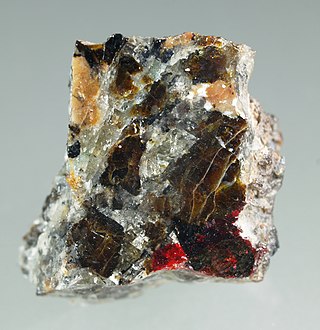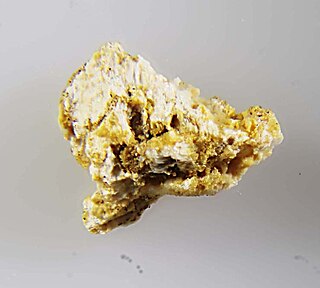Related Research Articles

Cohenite is a naturally occurring iron carbide mineral with the chemical structure (Fe, Ni, Co)3C. This forms a hard, shiny, silver mineral which was named by E. Weinschenk in 1889 after the German mineralogist Emil Cohen, who first described and analysed material from the Magura meteorite found near Slanica, Žilina Region, Slovakia. Cohenite is found in rod-like crystals in iron meteorites.
Tongbaite is a rare mineral that has the chemical formula Cr3C2, or chromium carbide.

Qingsongite is a rare boron nitride mineral with cubic crystalline form. It was first described in 2009 for an occurrence as minute inclusions within chromite deposits in the Luobusa ophiolite in the Shannan Prefecture, Tibet Autonomous Region, China. It was recognized as a mineral in August 2013 by the International Mineralogical Association. It is named after Chinese geologist Qingsong Fang (1939–2010). Qingsongite is the only known boron mineral that is formed deep in the Earth's mantle. Associated minerals or phases include osbornite, coesite, kyanite and amorphous carbon.

Chanabayaite is the first recognized triazolate mineral, having the formula Cu
2(N
3C
2H
2Cl
4.

Gurimite is a rare mineral with formula Ba3(VO4)2. It is a simple barium vanadate, one of the most simple barium minerals known. It is named after its type locality - Gurim anticline in Israel. It has formed in the rocks of the Hatrurim Formation. Gurimite's stoichiometry is similar to that of copper vanadates mcbirneyite and pseudolyonsite. An example of other barium vanadate mineral is tokyoite.
Feodosiyite is a very rare chloride mineral, just recently approved, with the formula Cu11Mg2Cl18(OH)8•16H2O. Its structure is unique. Feodosiyite comes from the Tolbachik volcano, famous for many rare fumarolic minerals. Chemically similar minerals, chlorides containing both copper and magnesium, include haydeeite, paratacamite-(Mg) and tondiite.
Peterandresenite is a very rare mineral, the first known natural hexaniobate. Its chemical formula is Mn4Nb6O19•14H2O. Its structure contains a special type of octahedron: Lindqvist ion. Peterandresenite was found in a pegmatite of the Larvik complex in Norway. It is somewhat similar to other unique niobium minerals, aspedamite and menezesite.
Heptasartorite is a very rare mineral with formula Tl7Pb22As55S108. It belongs to sartorite homologous series. It is related to other recently approved minerals of the series: enneasartorite and hendekasartorite. All three minerals come from a quarry in Lengenbach, Switzerland, which is famous of thallium minerals. Chemically similar minerals include edenharterite and hutchinsonite.
Kyawthuite is a rare mineral with a simple formula: Bi3+Sb5+O4. It is a natural bismuth antimonate. Kyawthuite is monoclinic, with space group I2/c, and is isostructural with clinocervantite, its trivalent-antimony-analogue. Kyawthuite is also an antimony-analogue of clinobisvanite. Kyawthuite was discovered in the vicinity of Mogok in Myanmar, an area famous for its variety of gemstone minerals. Only one sample of the naturally occurring form of this mineral has been found and is stored at the Natural History Museum of Los Angeles County.

Steinmetzite is a very rare phosphate mineral with formula Zn2Fe(PO4)2(OH)•3H2O. It was discovered among pegmatites of Hagendorf in Germany, that are famous for rare phosphate minerals. Steinmetzite is chemically related to phosphophyllite and other zinc iron phosphates, namely plimerite and zinclipscombite.
Vasilseverginite is a very rare arsenate-sulfate mineral with formula Cu9O4(AsO4)2(SO4)2. Its structure is of a new type. It possesses a typical feature of many minerals of its type locality, the Tolbachik volcano, namely being a salt with oxide anions. However, it is the first Tolbachik copper oxysalt that is both arsenate and sulfate. Vasilseverginite is monoclinic, with space group P21/n.
Bartelkeite is an exceptionally rare mineral, one of scarce natural germanium compounds. The formula was originally assumed to be PbFeGe3O8, bartelkeite was later shown to be isostructural with a high-pressure form of the mineral lawsonite. Thus, its correct formula is PbFeGe(Ge2O7)(OH)2•H2O. Bartelkeite and mathewrogersite are minerals with essential (dominant) lead, iron and germanium. Both come from Tsumeb, Namibia - a world's "capital" of germanium minerals.
Dyrnaesite-(La) is a rare-earth phosphate mineral with the formula Na
8Ce4+
(La,REE)
2(PO
4)
6. Dyrnaesite-(La) is related to vitusite-(Ce), another rare-earth phosphate mineral. It comes from lujavrite, a type of alkaline syenite rock, of South Greenland. Dyrnaesite-(La) is one of few known minerals with essential tetravalent cerium, the other two being cerianite-(Ce) and stetindite.
Fermiite is a rare uranium mineral with the formula Na4(UO2)(SO4)3·3H2O. Chemically related minerals include oppenheimerite, meisserite (which is also structurally-related to fermiite), belakovskiite, natrozippeite and plášilite. Fermiite comes from the Blue Lizard mine, San Juan County, Utah, USA, which is known for many rare uranium minerals. The name honors Enrico Fermi (1901–1954).
Faizievite is a very rare mineral with the formula K2Na(Ca6Na)Ti4Li6Si24O66F2. This triclinic mineral is chemically related to baratovite and katayamalite. Faizievite is a single-locality mineral, coming from the moraine of the Darai-Pioz glacier, Tien Shan Mountains, Tajikistan. Alkaline rocks of this site are famous for containing numerous rare minerals, often enriched in boron, caesium, lithium, titanium, rare earth elements, barium, and others.
Belakovskiite is a very rare uranium mineral with the formula Na7(UO2)(SO4)4(SO3OH)(H2O)3. It is interesting in being a natural uranyl salt with hydrosulfate anion, a feature shared with meisserite. Other chemically related minerals include fermiite, oppenheimerite, natrozippeite and plášilite. Most of these uranyl sulfate minerals was originally found in the Blue Lizard mine, San Juan County, Utah, US. The mineral is named after Russian mineralogist Dmitry Ilych Belakovskiy.
Meisserite is a very rare uranium mineral with the formula Na5(UO2)(SO4)3(SO3OH)(H2O). It is interesting in being a natural uranyl salt with hydrosulfate (hydroxysulfate) anion, a feature shared with belakovskiite. Other chemically related minerals include fermiite, oppenheimerite, natrozippeite and plášilite. Most of these uranyl sulfate minerals was originally found in the Blue Lizard mine, San Juan County, Utah, USA. The mineral is named after Swiss mineralogist Nicolas Meisser.
Chrysothallite is a rare thallium-bearing chloride mineral with the formula K6Cu6Tl3+Cl17(OH)4•H2O. Chrysothallite is unique in being only the second mineral with essential trivalent thallium, a feature shared with natural thallium(III) oxide, avicennite. Another examples of natural thallium chlorides are steropesite, Tl3BiCl6, and lafossaite, TlCl. Chrysothallite is one of numerous fumarolic minerals discovered among fumarolic sites of the Tolbachik volcano, Kamchatka, Russia The mineral is named in allusion to its colour and thallium content.
Grootfonteinite is a rare lead carbonate mineral with the relatively simple formula Pb3O(CO3)2. It is one of number of minerals discovered on in the Kombat mine, Grootfontein district, Namibia.
Manganiceladonite is a rare silicate mineral with the formula KMgMn3+Si4O10(OH)2. It is one of many minerals discovered in the Cerchiara mine, La Spezia, Liguria, Italy.
References
- ↑ Warr, L.N. (2021). "IMA–CNMNC approved mineral symbols". Mineralogical Magazine. 85 (3): 291–320. Bibcode:2021MinM...85..291W. doi: 10.1180/mgm.2021.43 . S2CID 235729616.
- ↑ Mindat
- ↑ Fang, Q., Bai, W., Yang, J., Xu, X., Li, G., Shi, N., Xiong, M., and Rong, H., 2009. Qusongite (WC): A new mineral. American Mineralogist 94(2-3), 387-390.
- ↑ "Qusongite: Qusongite mineral information and data". Mindat.org. Retrieved 2016-03-04.
- ↑ "Luobusha ophiolite ("Luobusa ophiolite"), Qusum Co. (Qusong Co.), Shannan Prefecture (Lhokha Prefecture; Lhoka Prefecture), Tibet Autonomous Region, China - Mindat.org". Mindat.org. Retrieved 2016-03-04.